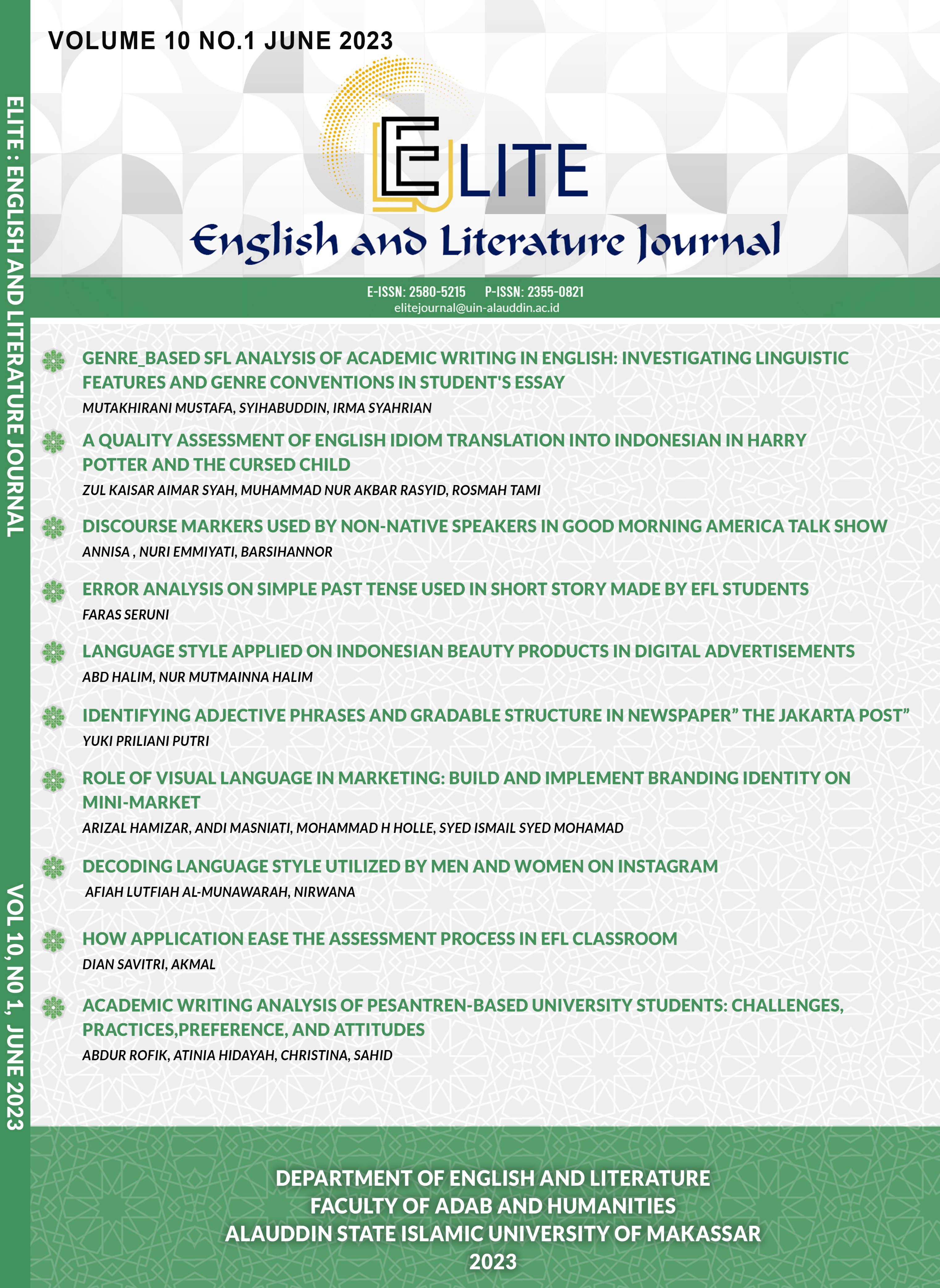Discourse Markers Used by Non-Native Speakers in Good Morning America Talk Show
Abstract
Discourse markers have been studied extensively in linguistics and communication studies. Its use is very helpful in understanding the message conveyed, both in formal and informal situations. This study examines the discourse markers used by non-native speakers in Good Morning America Talk Show. Unveil the types and their functions, this study uses a qualitative descriptive method in identifying the use of discourse markers. The data were taken from conversations of non-native speakers using Biber et al (1999) theory to determine the types and functions of discourse markers. The results of this study showed that there are ten types of discourse markers interjection, greetings and farewells, linking adverbials, stance adverbials, vocatives, response elicitors, response forms, hesitators, various polite speech-act formulas and expletives. Those markers have variations functions as marker of information management, marker of response, marker of connectives, marker of cause and effect, marker of temporal adverb and marker of information participation. This study has shown that the use of discourse markers varies across languages and cultures. Moreover, the use of discourse markers can also vary depending on the context of the communication.
Downloads
References
Alsahafi, M. (2020). A Narrative Discourse Analysis of Poe’s Short Story" The Tell-Tale Heart": Implications for Language Teaching. English Language Teaching, 13(1), 1–17. https://doi.org/10.5539/elt.v13n1p1
Biber, D. (1999). Discourse Markers in English Spoken Language; Types of Discourse Markers.
Carey, J. W. (2008). A Cultural Approach to Communication. Retrieved from https://www.taylorfrancis.com/chapters/mono/10.4324/9780203928912-9/cultural-approach-communication-james-carey
Crible, L., & Cuenca, M.-J. (2017). Discourse Markers in Speech: Distinctive Features and Corpus Annotation. Dialogue Discourse, 8, 149–166. Retrieved from https://journals.uic.edu/ojs/index.php/dad/article/view/10783/9543
Diskin, C. (2017). The use of the discourse-pragmatic marker ‘like’ by native and non-native speakers of English in Ireland. Journal of Pragmatics, 120, 144–157. Retrieved from https://www.sciencedirect.com/science/article/abs/pii/S0378216617300279?via%3Dihub
Erman, B. (2001). Pragmatic markers revisited with a focus on you know in adult and adolescent talk. Journal of Pragmatics, 33(9), 1337–1359. Retrieved from https://www.sciencedirect.com/science/article/pii/S0378216600000667
Fang, T., & Faure, G. O. (2011). Chinese communication characteristics: A Yin Yang perspective. International Journal of Intercultural Relations, 35(3), 320–333. Retrieved from https://citeseerx.ist.psu.edu/document?repid=rep1&type=pdf&doi=d8fb94229bd9e7cde451648d9394b9fc4aade413
Feng, H. (2011). Politeness (Keqi): The Fragrance of Chinese Communication. China Media Research, 7(4).
Forsell, L. M., & Åström, J. A. (2012). Meanings of hugging: From greeting behavior to touching implications. Comprehensive Psychology, 1, 2–17. https://doi.org/10.2466/02.17.21.CP.1.13
Fung, L., & Carter, R. (2007). Discourse markers and spoken English : Native and learner use in pedagogic settings. Applied Linguistics, 28, 410–439. https://doi.org/10.1093/applin/amm030
Hamilton, H. E., Tannen, D., & Schiffrin, D. (2015). The handbook of discourse analysis. John Wiley & Sons.
Holmes, J. (2013). An introduction to sociolinguistics. Retrieved from https://books.google.com/books?hl=id&lr=&id=iV_fAQAAQBAJ&oi=fnd&pg=PP1&dq=Holmes,+Janet.+2001.+An+Introduction+to+Sociolinguistics.+London:+Pearson+Education+Limited.+&ots=nNJg4Tx0Al&sig=fcRX0PwEJjBdEHfkTsUM4TIgcKM
Kendon, A. (2013). 1. Exploring the utterance roles of visible bodily action: A personal account. In Volume 1 (pp. 7–28). https://doi.org/10.1515/9783110261318.7
Levinson, S. C. (1983). Pragmatics. Retrieved from https://pure.mpg.de/rest/items/item_66467/component/file_66468/content
McNeill, D., & Duncan, S. D. (2000). Growth points in thinking-for-speaking. Language and Gesture, 1987, 141–161. Retrieved from http://mcneilllab.uchicago.edu/pdfs/GP-think-for-speak.pdf
Nuri, E. (2015). Discourse Analysis. Makassar: Alauddin University Press.
Rini, Y. F. S. (2019). Function and Type of Discourse Markers in Donald Trump’s Speech.
Rofiq, Z., & Priyono, E. S. (2021). Discourse Markers of Humor Analysis in Trevor Noah’s Stand-Up Comedy. Lingual Journal of Language and Culture, 11(1), 14. https://doi.org/10.24843/ljlc.2021.v11.i01.p03
Schiffrin, D. (1987). Frontmatter. In Studies in Interactional Sociolinguistics. Discourse Markers (pp. i–vi). Cambridge University Press.
Sibagariang, S., Ginting, S. A., & Sibarani, B. (2019). Discourse Markers In Essay Writing Of Senior High School Students. Genre Journal of Applied Linguistics of FBS Unimed. Retrieved from https://jurnal.unimed.ac.id/2012/index.php/ellu/article/view/12445/10702
Sun, W. (2013). The Importance of Discourse Markers in English Learning and Teaching. Retrieved from http://www.academypublication.com/issues/past/tpls/vol03/11/29.pdf
Takahashi, M. (2010). Talking to the driver: a cross-cultural comparison of bus etiquette in Canada and Japan. Journal of Bunkyo Gakuin University, Department of Foreign Languages and Bunkyo Gakuin College, 169–182. Retrieved from https://www.bgu.ac.jp/assets/old/center/library/image/fsell2009_169-182.pdf
Yule, G. (2022). The Study of Language. 22(2), 205–208. Retrieved from https://www.readingmatrix.com/files/29-qbd6hrx0.pdf
Zuhal, O., & ÖZER, H. Z. (2018). Discourse markers in EFL classrooms: A corpus-driven research. Journal of Language and Linguistic Studies, 14(1), 50–66. Retrieved from https://dergipark.org.tr/en/download/article-file/650133
Copyright (c) 2023 Annisa Annisa, Nuri Emmiyati

This work is licensed under a Creative Commons Attribution-NonCommercial-ShareAlike 4.0 International License.
Once an article was published in the journal, the author(s) are:
granted to the journal right licensed under Creative Commons License Attribution that allows others to share the work with an acknowledgement of the work's authorship.
permitted to publish their work online in third parties as it can lead wider dissemination of the work.
continue to be the copyright owner and allow the journal to publish the article with the CC BY-NC-SA 4.0 license
receiving a DOI (Digital Object Identifier) of the work.


